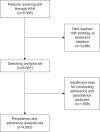Maintaining persistence and adherence with subcutaneous growth-hormone therapy in children: comparing jet-delivery and needle-based devices
- PMID: 25258519
- PMCID: PMC4172194
- DOI: 10.2147/PPA.S70019
Maintaining persistence and adherence with subcutaneous growth-hormone therapy in children: comparing jet-delivery and needle-based devices
Abstract
Purpose: Persistence and adherence with subcutaneous growth hormone (GH; somatropin) therapy in children is widely acknowledged to be suboptimal. This study aimed to investigate how the use of a jet-delivery device, ZomaJet(®), impacts on medication-taking behaviors compared to needle-based devices.
Materials and methods: A retrospective cohort study of children aged ≤18 years was conducted using a UK-based, nationwide database of GH home-delivery schedules. Data were evaluated for the period between January 2010 and December 2012 for 6,061 children receiving either Zomacton(®) (somatropin) via the ZomaJet jet-delivery device or one of six brands of GH all administered via needle-based devices. Persistence was analyzed for patients with appropriate data, measured as the time interval between first and last home deliveries. An analysis of adherence was conducted only for patients using ZomaJet who had appropriate data, measured by proportion of days covered. Brand switches were identified for all patients.
Results: Persistence with GH therapy was significantly longer in patients using ZomaJet compared to needle-based devices (599 days versus 535 days, respectively, n=4,093; P<0.001); this association was observed in both sexes and across age subgroups (≤10 and 11-16 years). The majority (58%) of patients using ZomaJet were classed as adherent (n=728). Only 297 patients (5%) switched GH brand (n=6,061), and patients tended to use ZomaJet for longer than other devices before switching.
Conclusion: It appears important that the choice of a jet-delivery device is offered to children prescribed daily GH therapy. These devices may represent a much-needed effective strategy for maintaining persistence with subcutaneous GH administration in children, potentially offering better clinical outcomes and greater cost-efficiency.
Keywords: adherence; children; growth hormone; jet delivery; persistence.
Figures





References
-
- National Institute for Health and Care Excellence . Human Growth Hormone (somatropin) for the Treatment of Growth Failure in Children. London: NICE; 2010.
-
- National Institute for Health and Care Excellence . Medicines Adherence: Involving Patients in Decisions about Prescribed Medicines and Supporting Adherence. London: NICE; 2009. - PubMed
-
- Cutfield W, Lindberg A, Albertsson Wikland K, Chatelain P, Ranke MB, Wilton P. Final height in idiopathic growth hormone deficiency: the KIGS experience. KIGS International Board. Acta Paediatr Suppl. 1999;88(428):72–75. - PubMed
LinkOut - more resources
Full Text Sources
Other Literature Sources

